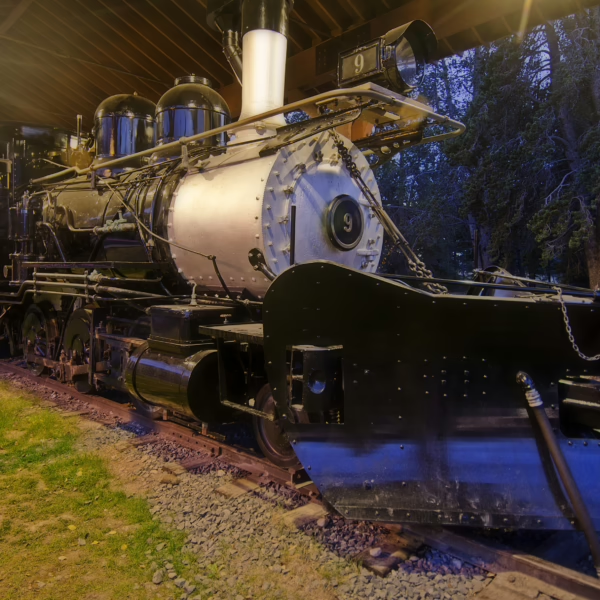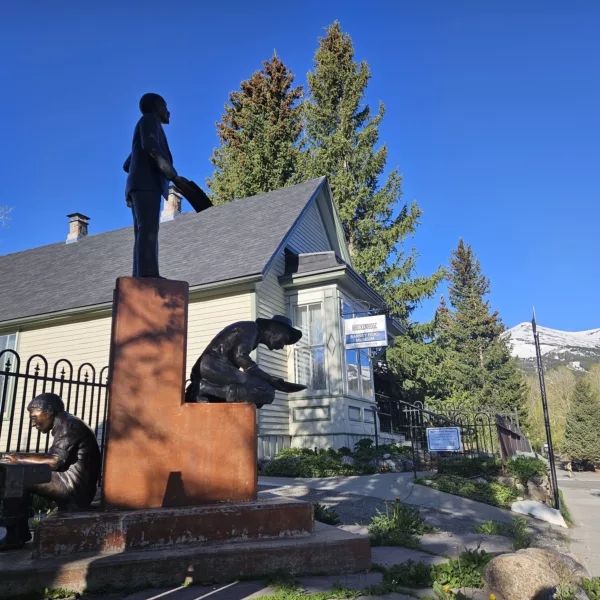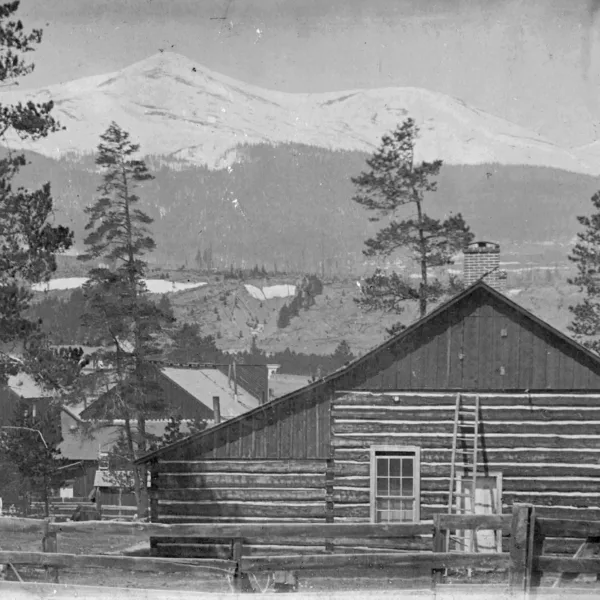Presión, preservación y el camino a seguir
May 30, 2024 | Category: Hacer historia
 Cuando cursaba estudios de posgrado en la Universidad de Michigan, estudié gestión de archivos y registros. Un profesor, el Dr. Wallace, nos habló de la "noche oscura del alma". Hicimos camisetas: un lobo aullando a la luna rodeado de las palabras "preparándose para la noche oscura del alma". Se convirtió en una cruzada, una vocación y una úlcera a punto de producirse. Si has trabajado en archivos, museos o en la conservación de sitios históricos, probablemente hayas experimentado la noche oscura, aunque no conocieras el término. Si no es así, se lo explicaré. Tenemos más de 100 sitios históricos, y tiempo, mano de obra y dinero limitados para salvarlos. Usted es un guardián del pasado, responsable del futuro. Las decisiones que tome hoy decidirán lo que se recordará y, lo que es más importante, lo que se olvidará. ¿Cómo elegir? ¿Se salva el sitio que está en peor estado? ¿El más accesible? ¿El que tiene más valor histórico, lo que abre toda una serie de interrogantes al intentar determinar para quién fue importante, lo fue en su momento o lo es ahora? ¿Y cómo se decide qué es importante en el futuro? Piensas en todas estas variables mientras te desvelas en mitad de la noche con la esperanza de haber tomado las decisiones correctas. Esa es la noche oscura, pero ¿qué es la preservación?
Cuando cursaba estudios de posgrado en la Universidad de Michigan, estudié gestión de archivos y registros. Un profesor, el Dr. Wallace, nos habló de la "noche oscura del alma". Hicimos camisetas: un lobo aullando a la luna rodeado de las palabras "preparándose para la noche oscura del alma". Se convirtió en una cruzada, una vocación y una úlcera a punto de producirse. Si has trabajado en archivos, museos o en la conservación de sitios históricos, probablemente hayas experimentado la noche oscura, aunque no conocieras el término. Si no es así, se lo explicaré. Tenemos más de 100 sitios históricos, y tiempo, mano de obra y dinero limitados para salvarlos. Usted es un guardián del pasado, responsable del futuro. Las decisiones que tome hoy decidirán lo que se recordará y, lo que es más importante, lo que se olvidará. ¿Cómo elegir? ¿Se salva el sitio que está en peor estado? ¿El más accesible? ¿El que tiene más valor histórico, lo que abre toda una serie de interrogantes al intentar determinar para quién fue importante, lo fue en su momento o lo es ahora? ¿Y cómo se decide qué es importante en el futuro? Piensas en todas estas variables mientras te desvelas en mitad de la noche con la esperanza de haber tomado las decisiones correctas. Esa es la noche oscura, pero ¿qué es la preservación?
Preservación de lugares históricos
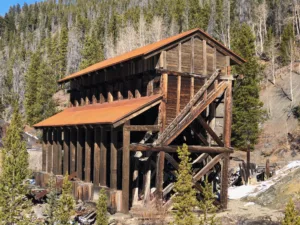
El molino Jessie después de que se añadiera un nuevo tejado para ayudar a preservar el lugar en 2023.
Aquí, en Breckenridge, estamos rodeados de nuestro pasado. El pueblo ute caminó durante miles de años por los mismos senderos que nosotros recorremos hoy. Esos mismos senderos han estado salpicados de minas y equipos mineros durante cientos de años. Incluso los museos de aquí, como el Edwin Carter Museum, existen desde hace más de 100 años. Nuestro pasado se encuentra con nuestro presente cada día si se sabe dónde mirar. Nuestro trabajo es asegurarnos de que las generaciones futuras sigan disfrutándolo y aprendiendo de él. Si ha estado aquí el tiempo suficiente, puede que se haya tropezado con el molino Jessie de 1893 en su anterior estado de deterioro. Puede que incluso haya pensado: "Alguien debería hacer algo al respecto". ¿Pero qué? ¿Crear una estructura nueva que reproduzca el pasado o salvar lo que aún existe? Elegimos ambas opciones. Tras los esfuerzos de estabilización en 2015, añadimos un nuevo tejado a la estructura el año pasado para imitar la línea histórica del tejado. Este verano, volveremos atrás y eliminaremos los rastros de nuestra presencia, para que puedas volver a tropezarte con la vista de la Jessie, y quizá esta vez te preguntes: "¿Te imaginas cómo era trabajar allí?". O dale una leída a nuestro panel de interpretación para saber exactamente cómo era.
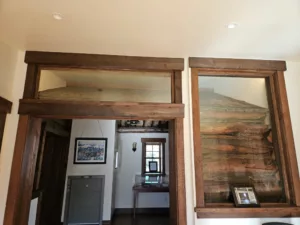
Una estructura original descubierta en el interior de la Casa Milne.
También hay otras formas de preservar los lugares históricos. Por ejemplo, fíjese en Milne Park, donde Breckenridge History tiene ahora nuestras oficinas e instalaciones para el cuidado de las colecciones. Se conservaron dos casas históricas y se transformaron en espacio utilizable. Estos edificios nos permiten ahora conservar artefactos del pasado de Breckenridge y exponerlos a la vista del público. También descubrimos muchas cosas durante el proceso de restauración, como la estructura original de una cabaña histórica y un alijo de artefactos escondidos en una pared: ¡pásate alguna vez para ver lo que hemos encontrado!
Preservar es acceder
Es estupendo preservar nuestra historia, pero ¿de qué sirve si nadie tiene acceso a ella? Cuando hablamos de acceso, a menudo nos referimos a archivos y colecciones de museos: los objetos de la historia. La gente quiere ver las fotos de Otto Westerman de 1800 y leer el manuscrito de Agnes Miner de los años cuarenta y cincuenta. Estos objetos adquieren importancia no sólo porque se conservan en condiciones seguras para las generaciones futuras, sino porque se puede interactuar con ellos ahora mismo.
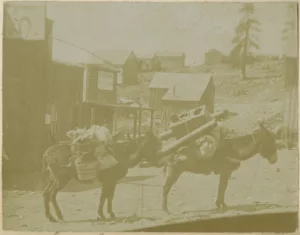
Un tren minero cargado de provisiones, incluida una estufa. Dos burros en un camino de tierra bordeado de edificios de madera.
La teoría archivística ha cambiado mucho a lo largo de los años. Antes era LOCKSS - Lots of Copies Keep Stuff Safe (Muchas copias mantienen las cosas a salvo). Quizá pueda adivinar cuáles eran sus inconvenientes. Después, Mark Greene, director del American Heritage Center de Laramie, Wyoming, introdujo MPLP - More Product Less Process (Más producto, menos proceso). Este cambio hacía hincapié en el acceso.
Cuando se recibe una colección hay una larga lista de cosas que hacer para estabilizarla, registrarla y prepararla para el acceso público. Greene hace hincapié en realizar este proceso lo antes posible para permitir el acceso público a las colecciones. Pero no es un proceso corto.
Quizá tenga el sótano lleno de fotos familiares y diarios metidos en cajas de cartón y bolsas de plástico. Puede que ni siquiera sepa exactamente qué hay allí. Cuando esos objetos se convierten en una colección de archivo, se vuelven a guardar en cajas de archivo que impiden que el material se degrade, se reorganizan en una colección -o la colección debe catalogarse al menos en su forma actual- y, gracias a toda nuestra tecnología moderna, se digitalizan para crear copias de acceso.
Estamos muy orgullosos de los Archivos Digitales de Historia de Breckenridge, que incluyen más de 1.800 objetos digitales, desde fotos históricas hasta grabaciones de historia oral e inventarios de yacimientos mineros, todos ellos fácilmente accesibles desde su ordenador en casa o dondequiera que se encuentre.
La conservación es educación

Visita guiada al Museo Barney Ford.
La educación puede tener lugar en el aula, pero también en una ruta de senderismo, un recorrido a pie o un museo. Ver un objeto es una cosa, pero escuchar la historia de por qué ese objeto es importante lleva la experiencia a otro nivel.
Nuestro Paseo por la Historia atraviesa el corazón de Breckenridge y cuenta las historias de las personas y los lugares que ayudaron a crear nuestra ciudad. Podrá ver fotos históricas de los edificios ante los que se encuentra. En nuestras caminatas guiadas, navegarás por los objetos físicos de la historia mientras aprendes cómo y cuándo se utilizaron.
En el Museo Barney Ford se entra literalmente en la casa de Ford de 1882. Su historia vive en la arquitectura, en sus palabras colgadas en la pared y en nuestros intérpretes, que te cuentan su viaje desde la esclavitud hasta convertirse en empresario y líder de los derechos civiles. Lo mismo ocurre con el Museo Edwin Carter, que vive en su cabaña, un museo que existe desde hace 149 años y que cuenta la historia de nuestro medio ambiente y nuestra fauna.
Esas historias y experiencias son la preservación. Es la versión de LOCKSS de los narradores. Si te contamos la historia, esa historia vive contigo, y quizá tú se la cuentes a otra persona, y antes de que nos demos cuenta nuestra historia se ha preservado a través de estas experiencias.
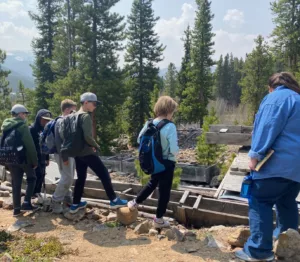
Una excursión guiada a Iowa Hill forma parte de nuestros programas educativos.
Con nuestros programas educativos, intentamos despertar esa curiosidad que hace que nuestros jóvenes quieran buscar esas historias. Quizá traigamos un juego de trenes y hablemos de los distintos vagones y de todo lo que han traído a nuestra ciudad, de cómo la han cambiado. Este momento de jugar con un juguete puede crear un mundo de asombro para nuestros alumnos. Tal vez, a partir de ahí, se dirijan al High Line Railroad Park y vean los trenes que recorrieron estos raíles. O tal vez recuerden la historia de personas que vinieron aquí sin nada con la esperanza de hacer una vida aquí, y eso resonará porque toca su propia historia. Si conseguimos que las generaciones futuras piensen en nuestra historia y en la suya propia, eso es preservación.

